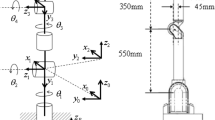Abstract
In this document, a control system is developed to allow a manipulator to learn and plan references from demonstrations given by an operator hand. Data entry is acquired by a sensor and is learned by the generalized learning model with least angle regression to create a desired reference in three dimensional space. A fifth reference profile is employed to smooth the desired reference. Direct and inverse kinematics are gotten to represent the transformation between the three dimensional space and each of the manipulator links. A dynamic model is gotten using Newton–Euler formulation. An evolving proportional derivative (PD) control is applied to get that the manipulator end effector follows the operator hand movements. The monitoring and control systems are implemented in an embedded platform for testing purposes.


















Similar content being viewed by others
Explore related subjects
Discover the latest articles, news and stories from top researchers in related subjects.References
Abdallah ZS, Gaber MM, Srinivasan B, Krishnaswamy S (2016) AnyNovel: detection of novel concepts in evolving data streams an application for activity recognition. Evol Syst 7(2):73–93
Angelov P, Yager R (2012) A new type of simplified fuzzy rule-based system. Int J Gen Syst 41(2):163–185
Angelov P, Skrjanc I, Blazic S (2015) A robust evolving cloud-based controller. In: Springer Handbook of Computational Intelligence, Springer, pp 1435–1449
Angelov P, Sadeghi-Tehran P, Ramezani R (2011) An approach to automatic real-time novelty detection, object identification, and tracking in video streams based on recursive density estimation and evolving Takagi-Sugeno fuzzy systems. Int J Intell Syst 26:189–205
Angelov P, Filev D, Kasabov N (2010) Evolving intelligent systems—methodology and applications. Wiley, New York
Angelov P (2012) Autonomous learning systems: from data streams to knowledge in real-time. Wiley, New York
Calderon CA, Ramirez C, Barros V, Punin G (2017) Design and deployment of grasp control system applied to robotic hand prosthesis. IEEE Latin Am Trans 15(2):181–188
Fraley C, Hesterberg T (2009) Least angle regression and LASSO for large datasets. Stat Anal Data Min 1:251–259
Garcia MA, Gallardo J, Rodriguez R, Alcaraz LA (2017) A new four-degrees-of-freedom parallel manipulator. IEEE Latin Am Trans 15(5):928–934
Hernandez K, Bacca B, Posso B (2017) Multi-goal path planning autonomous system for picking up and delivery tasks in mobile robotics. IEEE Latin Am Trans 15(2):232–238
Iliadis L, Margaritis K, Maglogiannis I (2016) Timely advances in evolving neural-based systems special issue. Evol Syst 8(1):1–2
Kangin D, Angelov P, Iglesias JA (2016) Autonomously evolving classifier TEDAClass. Inf Sci 366:1–11
Kasabov N (2007) Evolving connectionist systems: the knowledge engineering approach, 2nd edn. Springer, London
Khamassi I, Sayed-Mouchaweh M, Hammami M, Ghedira K (2016) Discussion and review on evolving data streams and concept drift adapting. Evol Syst. https://doi.org/10.1007/s12530-016-9168-2
Maciel L, Ballini R, Gomide F (2016) Evolving granular analytics for interval time series forecasting. Granul Comput 1:213–224
Marques Silva A, Caminhas W, Lemos A, Gomide F (2014) A fast learning algorithm for evolving neo-fuzzy neuron. Appl Soft Comput 14:194–209
Li X, Pan Y, Chen G, Yu H (2017) Multi-modal control scheme for rehabilitation robotic exoskeletons. Int J Robot Res 36(5):759–777
Liu Z, Liu J (2017) Adaptive iterative learning boundary control of a flexible manipulator with guarantted transient performance. Asian J Control 19(4):1–12
Lughofer E (2013) On-line assurance of interpretability criteria in evolving fuzzy systems—achievements, new concepts and open issues. Inf Sci 251:22–46
Lughofer E, Cernuda C, Kindermann S, Pratama M (2015) Generalized smart evolving fuzzy systems. Evol Syst 6:269–292
Lughofer E (2016) Evolving fuzzy systems—fundamentals, reliability, interpretability and useability. In: Angelov P (ed) Handbook of computational intelligence. World Scientific, New York, pp 67–135
Paramo Carranza LA, Meda Campaña JA, Rubio JJ, Tapia Herrera R, Curtidor Lopez AV, Grande Meza A, Cazares Ramirez I (2017) Discrete-time Kalman filter for Takagi–Sugeno fuzzy models. Evol Syst 8(3):211–219
Peng Y, Liu J, He W (2017) Boundary control for a flexible inverted pendulum system based on a pde model. Asian J Control 19(2):1–10
Pratama M, Lu J, Lughofer E, Zhang G, Anavatti S (2016) Scaffolding type-2 classifier for incremental learning under concept drifts. Neurocomputing 191:304–329
Pratama M, Lu J, Anavatti S, Lughofer E, Lim C-P (2016) An incremental meta-cognitive-based scaffolding fuzzy neural network. Neurocomputing 171:89–105
Precup R-E, Tomescu ML, Radac M-B, Petriu EM, Preitl S, Dragos C-A (2012) Iterative performance improvement of fuzzy control systems for three tank systems. Expert Syst Appl 39:8288–8299
Precup R-E, Filip H-I, Radac M-B, Petriu EM, Preitl S, Dragos C-A (2014) Online identification of evolving Takagi-Sugeno-Kang fuzzy modelsfor crane systems. Appl Soft Comput 24:1155–1163
Rosado WMA, Valdes LGV, Ortega AB, Ascencio JR, Beltran CDG (2017) Passive rehabilitation exercises with an ankle rehabilitation prototype based in a robot parallel structure. IEEE Latin Am Trans 15(1):48–56
Rubio JJ, Cruz P, Paramo LA, Meda JA, Mujica D, Ortigoza RS (2016) PID anti-vibration control of a robotic arm. IEEE Latin Am Trans 14(7):3144–3150
Sa STL, Fernandes CC, Yanaguibashi EA, Barros RP, Burlamaqui AMF, Goncalves LMG (2017) Educaval: towards assessment of educational robotics softwares. IEEE Latin Am Trans 15(4):720–728
Sayed-Mouchaweh M, Lughofer E (2012) Learning in non-stationary environments: methods and applications. Springer, New York
Serrano ME, Godoy SA, Romoli S, Scaglia GJE (2018) A numerical approximation-based controller for mobile robots with velocity limitation. Asian J Control 20(1):1–13
Venkatesan R, Er MJ, Dave M, Pratama M, Wu S (2016) A novel online multi-label classifier for high-speed streaming data applications. Evol Syst 8(4):303–315
Zhang C, Sun T, Pan Y (2014) Neural network observer-based finite-time formation control of mobile robots. Math Probl Eng 2014:1–9
Acknowledgements
Authors thank the Editor in Chief, and reviewers for their valuable comments which let to improve this result. They thank the Instituto Politécnico Nacional, the Consejo Nacional de Ciencia y Tecnología, and Secretaría de Investigación y Posgrado for their support.
Author information
Authors and Affiliations
Corresponding author
Rights and permissions
About this article
Cite this article
Rubio, J.d.J., Garcia, E., Aquino, G. et al. Learning of operator hand movements via least angle regression to be teached in a manipulator. Evolving Systems 11, 317–332 (2020). https://doi.org/10.1007/s12530-018-9224-1
Received:
Accepted:
Published:
Issue Date:
DOI: https://doi.org/10.1007/s12530-018-9224-1




